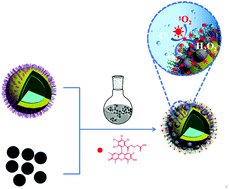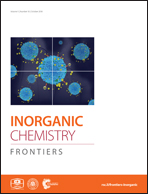Surface ligand coordination induced self-assembly of a nanohybrid for efficient photodynamic therapy and imaging†
Abstract
Nanohybrids have greatly promoted the application of nanomaterials in real world problems, since they not only present the individual advanced properties of each material, but can also realize the amplification of the functions of the combined materials. Here, we assembled up-conversion nanoparticles NaYF4,Yb/Er@NaYF4 (UCNPs) and MnFe2O4 (MF) into a multi-functional nanohybrid through direct coordination using polyacrylic acid (PAA) as the surficial bridging linker. Afterwards, the photosensitizer molecules Rose Bengal (RB) and PEG-COOH were covalently grafted onto the nanohybrid. UCNPs effectively stimulated RB by means of fluorescence resonance energy transfer effects to convert O2 to 1O2. Meanwhile, the MF NPs worked as a Fenton catalyst to continuously generate O2 by decomposing H2O2 in the H2O2 over-expression tumor micro-environment. Thus, a comprehensive therapeutic system was successfully constructed, which can efficiently perform photodynamic therapy (PDT) of hypoxic tumors under the excitation of a 980 nm laser. This work explored a new method for the assembly of nanohybrids using heterogeneous nanomaterials by coordination with bridging ligands between NPs and provided a versatile PDT candidate for hypoxic tumors.



 Please wait while we load your content...
Please wait while we load your content...